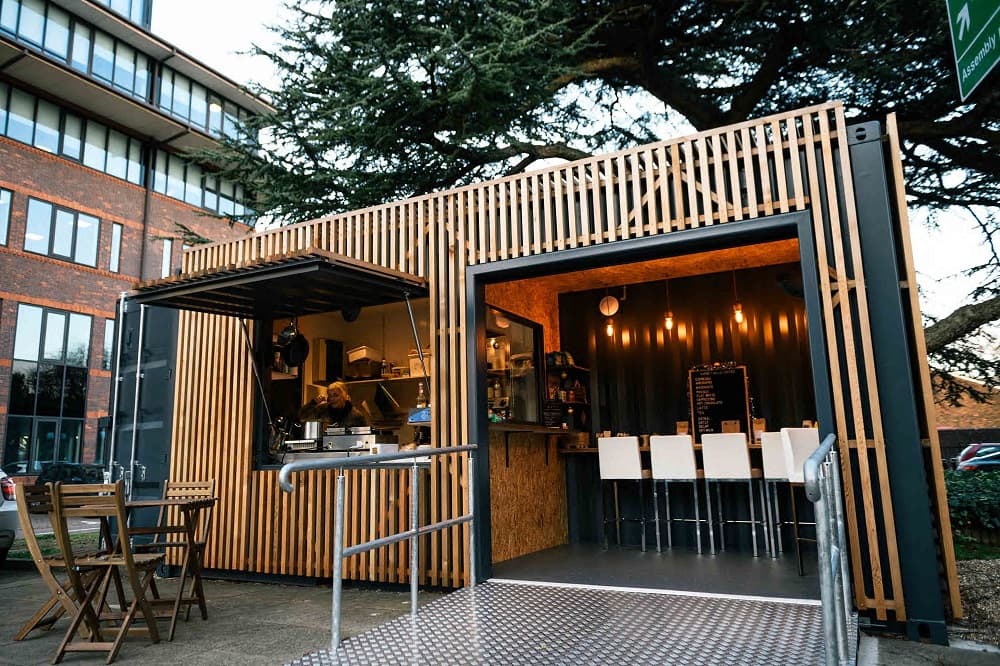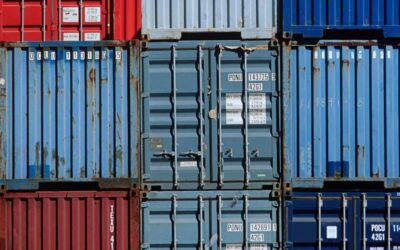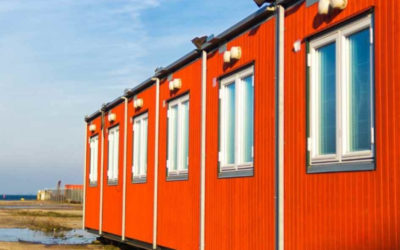In the world of design and architecture, there’s a growing trend that’s transforming the way we think about shipping containers. These once-utilitarian metal boxes are now being given a new lease on life through the power of cladding.
Shipping container modifications are all the rage and for good reason.
Cladding, the process of covering the exterior walls of a container with a different material, not only enhances its aesthetic appeal but also improves its functionality and durability.
From sleek timber finishes to modern glass facades, the possibilities are endless when it comes to giving shipping containers a stylish makeover.
Whether you’re looking to create a unique home, a trendy café, or a versatile office space, cladding offers the perfect solution.
In this post, we’ll explore the power of cladding and how it’s revolutionising the shipping container industry.
Benefits of using cladding for shipping container makeovers
Cladding offers a wide range of benefits when it comes to transforming shipping containers into functional and visually appealing structures.
Firstly, cladding helps to improve the insulation properties of the container, making it more energy-efficient and comfortable to inhabit. By adding a layer of insulation material between the container walls and the cladding, you can effectively regulate the temperature inside, reducing the need for excessive heating or cooling. This is especially beneficial for those looking to create a liveable space out of a shipping container, such as a home or an office.
Secondly, cladding enhances the structural integrity of the container, making it more resistant to external factors such as weather conditions and wear and tear.
The cladding material acts as a protective layer, shielding the container from moisture, UV rays, and other environmental elements that can cause corrosion and deterioration over time. With the right cladding material, you can significantly extend the lifespan of a shipping container and ensure its long-term durability.
Lastly, cladding allows for endless design possibilities, enabling you to customise the look and feel of your shipping container according to your preferences.
Whether you prefer a rustic, industrial aesthetic or a sleek, modern design, there’s a cladding material out there to suit your style. From natural timber finishes to sleek metal panels, the choice is yours. Cladding also provides the opportunity to add windows, doors, and other architectural features, further enhancing the functionality and visual appeal of the container.
With these benefits in mind, it’s no wonder that cladding has become a popular choice for those looking to repurpose shipping containers into unique and versatile spaces.
Types of cladding materials for shipping containers

When it comes to cladding a shipping container, there are numerous materials to choose from, each with its own unique properties and aesthetic appeal. Here are some of the most popular cladding materials used in shipping container makeovers:
1. Timber
Timber cladding is a timeless option that brings warmth and a natural look to a shipping container. Whether you opt for hardwood or softwood, timber cladding can create a cosy and inviting atmosphere. It can be stained or painted in various colours to suit your desired aesthetic. Timber cladding also offers excellent insulation properties, making it an energy-efficient choice.
2. Metal
Metal cladding, such as steel or aluminium panels, provides a sleek and industrial look to shipping containers. It’s a durable and low-maintenance option that can withstand harsh weather conditions. Metal cladding is available in a variety of finishes, including brushed, mirrored, or powder-coated, allowing you to achieve the desired visual effect.
3. Brick
Brick cladding gives shipping containers a classic and timeless appearance. It adds a sense of solidity and permanence to the structure. Brick cladding can be achieved using real bricks or brick veneers, depending on the desired look and budget. The natural thermal properties of bricks also contribute to the insulation of the container.
4. Glass
Glass cladding is a modern and elegant option that allows for abundant natural light and stunning views. It creates a seamless connection between the interior and the surrounding environment. While glass cladding may require additional structural support, it offers a contemporary and sophisticated aesthetic.
These are just a few examples of the wide range of cladding materials available for shipping container makeovers. The choice of cladding material ultimately depends on factors such as the desired style, budget, and functional requirements of the project.
Factors to consider when choosing cladding for shipping containers
When selecting the cladding material for a shipping container makeover, it’s crucial to consider several factors to ensure the best results. Here are some key considerations:
- Climate and weather conditions: The climate of the location where the container will be placed plays a significant role in determining the most suitable cladding material. If the area experiences extreme temperatures or high humidity, it’s important to choose a material that can withstand these conditions without deteriorating or losing its aesthetic appeal.
- Budget: The cost of cladding materials can vary significantly, so it’s essential to establish a budget beforehand. Consider the cost of both the cladding material itself and any additional installation or maintenance expenses.
- Durability and maintenance: Some cladding materials require more maintenance than others. Consider the long-term maintenance requirements of the chosen material and whether it aligns with your desired level of upkeep.
- Building regulations and permits: Before embarking on a shipping container makeover project, check local building regulations and permit requirements. Some areas may have specific guidelines regarding the use of shipping containers as habitable structures or the types of cladding materials that can be used.
By carefully considering these factors, you can choose the cladding material that best suits your needs and ensures a successful shipping container makeover. However, it’s also important to be aware of the potential cost considerations associated with cladding, which will be discussed in the next section.
Cost considerations for cladding a shipping container
Cladding a shipping container can be a cost-effective way to create a unique and functional space. However, it’s crucial to consider the various expenses involved in the cladding process. Here are some cost considerations to keep in mind:
- Cladding material
The cost of the cladding material itself will vary depending on the type, quality, and quantity required. While some materials may be more affordable upfront, others may offer greater durability and longevity, ultimately leading to cost savings in the long run.
- Installation
The installation process can also contribute to the overall cost. If you choose to hire professionals for the job, their fees should be factored into the budget. DIY installations may save money but consider the time and effort required, as well as the need for specialized tools.
- Additional features
If you plan to add windows, doors, or other architectural elements to the container, these features will incur additional costs. Consider the materials, labour, and any necessary permits or certifications when budgeting for these additions.
- Maintenance
While some cladding materials require minimal maintenance, others may need regular care and upkeep. Consider the long-term maintenance costs associated with the chosen material and factor them into your budget.
It’s important to establish a comprehensive budget that accounts for all these cost considerations to ensure a successful shipping container makeover project. By doing so, you can create a stylish and functional space without breaking the bank. In addition to the cost benefits, cladding shipping containers also offer several eco-friendly advantages, which will be discussed in the next section.
Eco-friendly benefits of cladding for shipping container modifications
Cladding shipping containers not only transforms them into visually appealing structures but also brings several eco-friendly benefits. Here are some of the environmental advantages of cladding:
1. Reuse and repurpose: By repurposing shipping containers, you’re giving them a new life and preventing them from ending up in landfills. Instead of being discarded, these containers can be transformed into sustainable and functional spaces, reducing the demand for new construction materials.
2. Energy efficiency: Cladding can significantly improve the energy efficiency of shipping containers. By adding insulation materials between the container walls and the cladding, you can reduce heat transfer and minimise the need for excessive heating or cooling. This leads to lower energy consumption and reduced carbon emissions.
3. Sustainable cladding materials: Many cladding materials used in shipping container makeovers are sourced from sustainable and renewable resources. For example, timber cladding can be sourced from responsibly managed forests, while metal cladding can be made from recycled materials. Choosing eco-friendly cladding materials further enhances the sustainability of the project.
4. Durability and longevity: Cladding not only enhances the visual appeal of shipping containers but also improves their durability. By protecting the container from harsh weather conditions and minimising corrosion, cladding extends the lifespan of the structure. This reduces the need for frequent replacement and, in turn, reduces the environmental impact associated with new construction.
By opting for cladding in shipping container modifications, you’re not only creating unique and stylish spaces but also making a positive impact on the environment. It’s a win-win situation that combines aesthetics with sustainability.
Summary
Shipping container modifications have become a global trend, thanks to the power of cladding. By covering the exterior walls of a container with different materials, cladding transforms these utilitarian structures into unique and stylish spaces.
The benefits of cladding are numerous, from improved insulation and structural integrity to endless design possibilities. With the right cladding material, you can create a functional, energy-efficient, and visually stunning space out of a shipping container.
Once cladded, shipping containers require minimal maintenance and offer increased durability. The protective layer provided by the cladding material reduces the risk of corrosion and damage caused by weather conditions. Repairs and replacements, if needed, can be done on a smaller scale, making maintenance more cost-effective.
In summary, cladding is a powerful tool that is helping to change the shipping container industry, especially the opportunities to modify a container so it can be used for more than shipping goods.
It enables the creation of functional, visually appealing, and sustainable spaces that can be used for various purposes. So, whether you’re considering a unique home, a trendy café, or a versatile office space, embrace the power of cladding and let your imagination run wild. The possibilities are endless!
If you are interested to learn more about shipping containers and their uses, talk to the team at OZBOX today and we can let you know more about our shipping containers for sale and for hire here in Australia and your options for modification.









